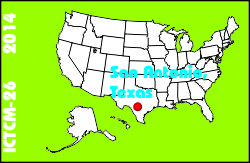
Electronic Proceedings of the Twenty-sixth Annual International Conference on Technology in Collegiate MathematicsSan Antonio, Texas, March 20-23, 2014Paper S064
Scientific Computing and Programming in the Cloud Using Open Source Platforms: An Illustration Using Weighted Voting Systems |
Mohamed I. JamaloodeenSchool of Science and Technology Georgia Gwinnet College 1000 University Center Lane Lawrenceville, GA 30043 mjamaloo@ggc.edu |
| Click to access this paper: |
ABSTRACT
There are by now several cloud computing engines, the most widely known of which is wolframalpha.com. One may type Mathematicalike commands and syntax into a dialog box on a web browser and have the computational results performed on a Mathematica server and these sent back to the client web browser. There are several other cloud computers including 'R on cloud' (for R statistical computing) and Scilab on Cloud India (for Scilab numerical computing). Scilab is an opensource numerical computational platform similar in many respects to Matlab. We illustrate the ease and versatility of the Scilab cloud computer with several short voting routines. We present Scilab routines to calculate voter power indices based on (1) the Banzhaf power index, (2) the ShapleyShubik power index, (3) The Johnston power index and (4) the randomized ShapleyShubik power index calculator based on the Central Limit theorem. We use these algorithms to illustrate the ease of writing short Scilab programs as well as to illustrate the powerful builtin routines in Scilab especially for random number generation. We then perform these calculations by simply copying and pasting the instructions into a web browser to be performed by the Scilab cloud server and the results sent back to the client web browser. It can be argued that cloud computing is a trend that may compete, if not displace, the apps paradigm for mobile devices. As an alternative to installing apps on a mobile device a user with an Internet connection and a browser interface may choose the computing power offered through a cloud computing service.Keyword(s): software
